Significant Moments in SXU History
To recount the history of Saint Xavier University is to traverse decades of stories and characters, turmoil and achievement, dedication and change that range across amazing shifts in society and therefore in educational expectations and practices. Through it all, Saint Xavier was there -- sometimes reacting or resisting, sometimes leading, always asking how to continue its mission of education in the context of an ever-evolving Catholic Church, Sister of Mercy community, and United States culture. Some significant moments, however, can serve as pivot points around which Saint Xavier's more complete history turns.

2023
Saint Xavier University restructures into two colleges: The College of Nursing, Health
Sciences and Business and the College of Liberal Arts and Education.
Saint Xavier University marks ten consecutive years of being ranked within the top 10 for "Best Online Graduate Nursing Program" by U.S. News & World Report.

2022
SXU launches one of the first esports programs in Chicago, strengthening and diversifying its athletic portfolio and rounding the total number of athletic varsity teams to 20.

2021
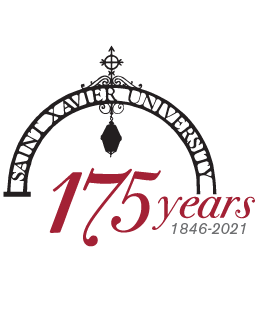 Saint Xavier University celebrates 175 years of educational service in and beyond Chicago.
Saint Xavier University celebrates 175 years of educational service in and beyond Chicago.
Saint Xavier University is awarded two major five-year grants from the U.S. Department of Education to build support and strengthen resources for students. Funded by the Title V Hispanic-Serving Institutions Program, the Enlace grant (P031S210208) secured $2,867,919 and the Conexiones grant, funded under the Hispanic-Serving Institutions STEM Program (P031C210201), secured $4,571,166 for SXU.

2020
Saint Xavier University achieves an enrollment milestone in welcoming its largest freshman class in the institution's nearly 175-year history, despite challenges posed by COVID-19.
Saint Xavier University introduces the Center for Inclusive Excellence, designed to serve as a catalyst for ongoing diversity, equity and inclusion initiatives.
Saint Xavier University partners with City Colleges for a Guaranteed Admission Agreement, creating a clear path to a bachelor’s degree for eligible transfer students.
Saint Xavier University becomes a Military Friendly® School, considered an institution whose commitment to serving the military and veteran community creates sustainable and meaningful opportunities for them.

2018
Saint Xavier University was awarded a $1.46 million grant from the National Science Foundation (NSF) to support classroom research and work-readiness programs for science, technology, engineering and mathematics (STEM) students as part of the NSF's Improving Undergraduate STEM Education: Hispanic Serving Institutions program.
Saint Xavier University welcomed its largest enrolled freshman class in its 172-year history.
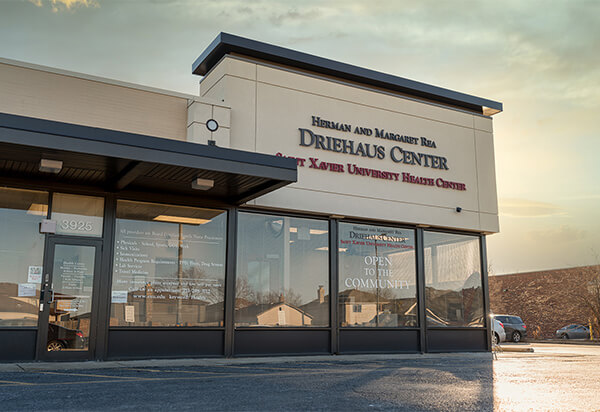
In July, the Saint Xavier University Health Center moved to 3925 W. 103rd Street to
provide easier access to members of the SXU community and those of the surrounding
neighborhood. The Health Center is now part of SXU's renovated Driehaus Center, which
includes Gilhooley's and the Counseling Center, which also moved to its new location
in July.
The School of Nursing expands to the School of Nursing and Health Sciences. The school expands to include communication sciences and disorders, gerontology, exercise science and physical education.

2016
Saint Xavier University celebrates 170 years of educational service in and beyond Chicago.
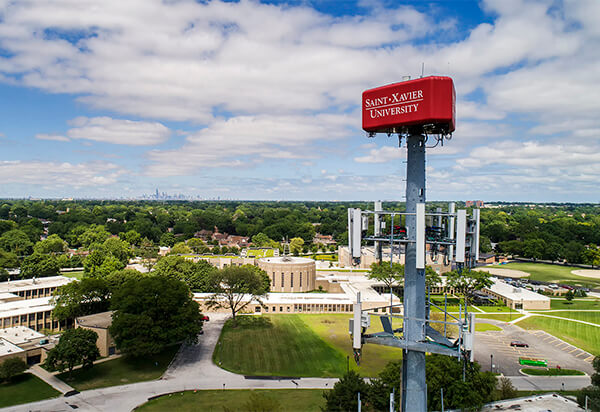
WXAV 88.3 FM celebrates 25 years on the airwaves

2014
Saint Xavier University's Chicago campus opened a Student Veteran Resource Center.
Chicago's Mayor Emanuel announced a long-term partnership between Saint Xavier University and Morgan Park High School. The high school will now be able to offer students access to a dual enrollment and credit program.
Chicago's Mayor Emanuel announced a long-term partnership between Saint Xavier University and Morgan Park High School. The high school will now be able to offer students access to a dual enrollment and credit program.

2011
Saint Xavier University wins first-ever Russell Athletic-NAIA National Football Championship.
Saint Xavier University celebrates grand re-opening of newly renovated Robert and
Mary Rita Murphy Stump Library.

2010
Christine M. Wiseman, J.D. becomes the 19th president of Saint Xavier University.

2009
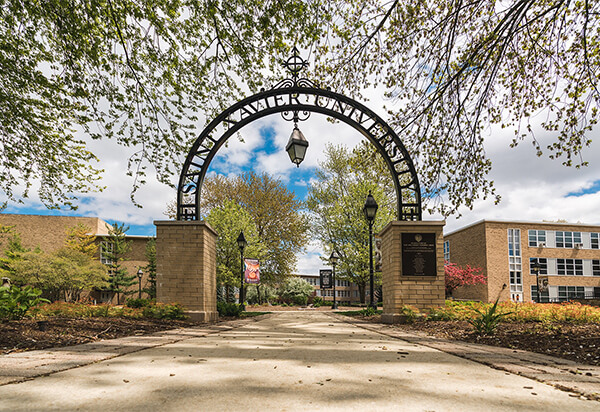
The 49th Street Gateway Arch replica is installed at the 103rd Street campus, at the
entry to the Morris-Schmitt Quad.
Saint Xavier University announces the naming of the Robert and Mary Rita Murphy Stump Library.
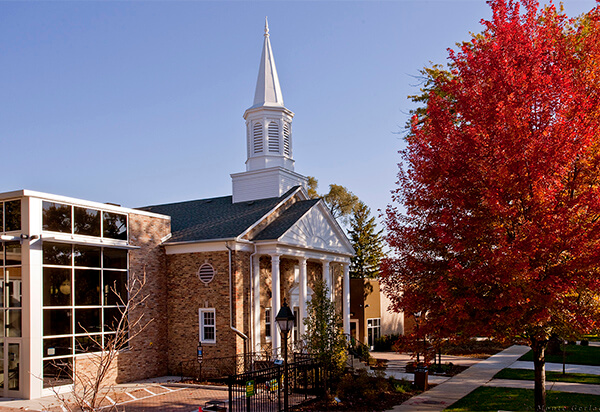
The University expands to two new locations in former neighborhood church buildings
-- one renovated to house the Art Department and the other, to be known as the Sister
Mary Denis O'Grady Center, designed as a one-stop marketing communications, media
relations and fundraising center housing the Office of University Relations and the
Office of University Advancement.

2008
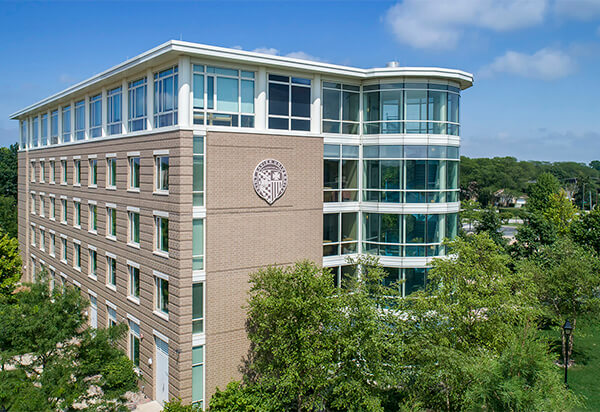
O'Brien Hall opens; it is SXU's second LEED Gold-certified residence building.

2007
The School of Nursing is recognized as a Center of Excellence in Nursing Education by the National League for Nursing.
After three years of study and design by an interdisciplinary faculty task force, University faculty members approve a new general education program.
The School of Arts and Sciences becomes the College of Arts and Sciences.
An affiliation agreement between Saint Xavier University and the Conference for Mercy Higher Education (CMHE) transfers the University's Mercy sponsorship from the Regional Community of Chicago to CMHE, the newly created sponsorship entity for 16 Mercy-founded colleges and universities in the United States.

2006
The Office for Mission and Heritage launches its Catholic Colloquium Lecture Series to explore the responsibilities of a Catholic university as a resource for examining contemporary civic and social questions and for developing healthy, active spiritual lives. Speakers in the series include Peter Steinfels, R. Scott Appleby, Sister Mary Aquin O'Neill, R.S.M., Rev. Robert E. Barron, Rev. Otis Moss, III, and Lawrence Cunningham.
Saint Xavier University celebrates 160 years of educational service in and beyond
Chicago.
Saint Xavier's Rubloff Hall becomes the first LEED Gold-certified student residence building in Chicagoland and the second such facility in Illinois.

2004
Saint Xavier University establishes the Office for Mission and Heritage.

2003
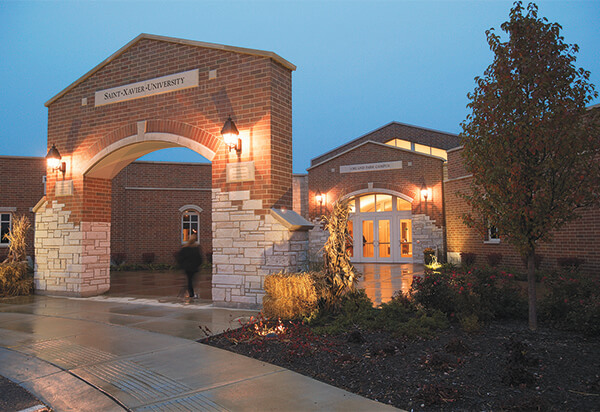
Saint Xavier builds a state-of-the-art facility and creates the new Orland Park Campus
on a generously donated 35-acre site near Interstate 80 in Orland Park.

2002
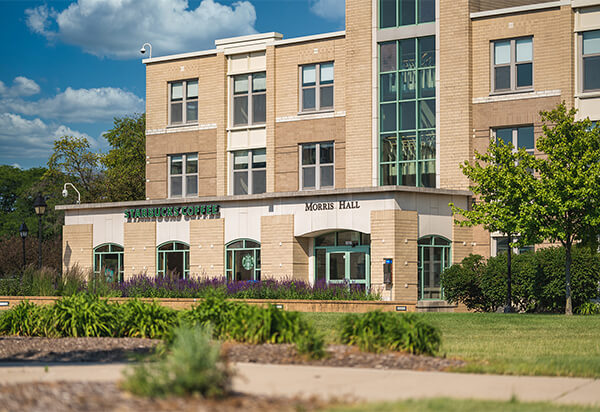
Morris Hall opens, continuing to expand the opportunity for students to live on campus.

2001
McCarthy Hall, a new student residence, opens.
Saint Xavier University establishes the Center for Religion and Public Discourse to advance thoughtful and respectful discussion and scholarship, relating academic disciplines and contemporary concerns to ethical, spiritual and religious perspectives. The Center inaugurates the Squeaky Weal Lecture Series, attracting such guest speakers as poets W.S. Merwin and Lisel Mueller, journalists Carol Marin and Bill Kurtis, personalities Bill Rancic and Kathleen Kennedy Townsend.

2000
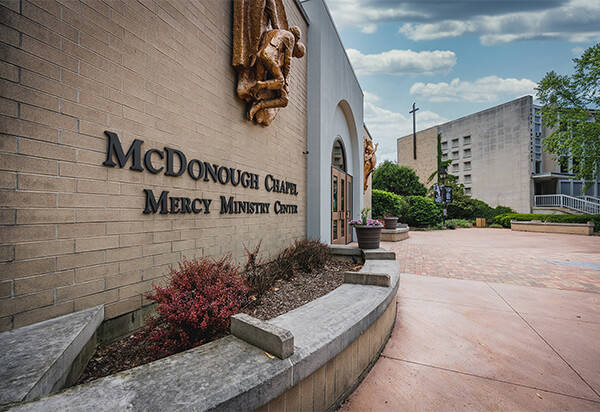
The McDonough Chapel and the Mercy Ministry Center open, realizing a long-deferred
dream of a free-standing chapel and associated ministry space.

1999
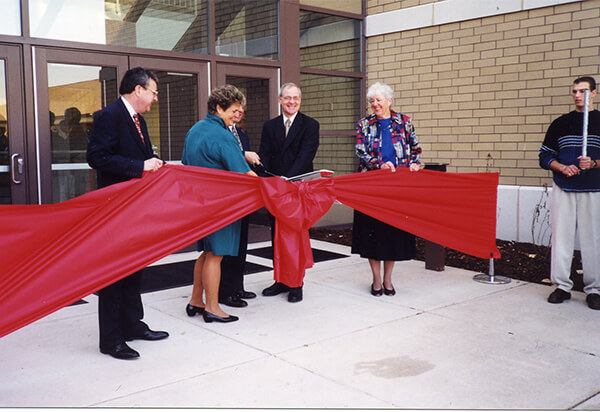
The University completes construction of the Shannon Convocation and Athletic Center,
making it possible to host athletic contests and special events, including graduation,
in a facility that seats up to 3,200 persons.
Saint Xavier University inaugurates an Honors Program that provides an intensive, four-year, interdisciplinary program for qualifying students.

1997
Saint Xavier establishes a Center for Off-Campus and International Program Development.
Saint Xavier University organizes its Adult College.

1996
Saint Xavier celebrates 150 years of educational service to Chicagoland.

1995
Andrew Conference Center opens.

1992
Saint Xavier College becomes Saint Xavier University.

1990
The Renaissance Academy, organized under Saint Xavier sponsorship, heightens the inter-generational character of the campus community.
The College establishes the School of Arts and Sciences.

1989
The College reorganizes its Education Center (department) as the School of Education.

1985
Saint Xavier first extends its campus across 103rd Street, opening the Graham School of Management in a renovated public school building.

1984
In partnership with the then Illinois Renewal Institute, Saint Xavier's Education Center begins offering graduate courses at sites across Illinois. Eventually, this partnership evolves into the off campus master's degree programs.

1983
SXC's Department of Business Administration becomes the Graham School of Management and inaugurates its MBA program.

1978
Saint Xavier launches its Weekend College with four baccalaureate programs -- business administration, criminal justice, humanities and nursing.

1975
Saint Xavier establishes a Campus Ministry program and selects a lay person as the program's first director.

1969
After considerable discussion, Saint Xavier becomes coeducational, enrolling its first undergraduate males for January 1969.

1968
Using a Science Department telephone and teletype link to the Illinois Institute of Technology, Saint Xavier gains its first access to computers.

1966
Saint Xavier organizes a Continuing Education Program designed to help adult women reenter the academic world and complete interrupted studies toward a degree.
Saint Xavier first names lay persons to its Board of Trustees.
The School of Nursing receives formal recognition as an entity within the College having the rights and responsibilities usually associated with academic designation as a "School."
Despite initial opposition by then Archbishop John Cody, Saint Xavier hosts the John XXIII Theological Symposium, drawing over 4,000 participants to hear the major theologians of the Second Vatican Council discuss what that Council would mean for the future of the Catholic Church.

1965
Saint Xavier faculty members approve their first set of faculty bylaws subsequently affirmed by the Board of Trustees. A faculty handbook follows in the same year.

1963
Saint Xavier's School of Nursing initiates its first graduate degree program, a master of science in psychiatric nursing.

1962
As a "center of excellence," Saint Xavier College is named as the only Catholic women's college and one of 35 private liberal arts colleges in the United States to receive a Ford Foundation Special Program in Education grant. It's an unrestricted matching grant of $1.5 million; to meet the match, SXC raises $3 million before June 30, 1965.

1961
Saint Xavier College confers its first master's degrees -- in theology and in education.

1959
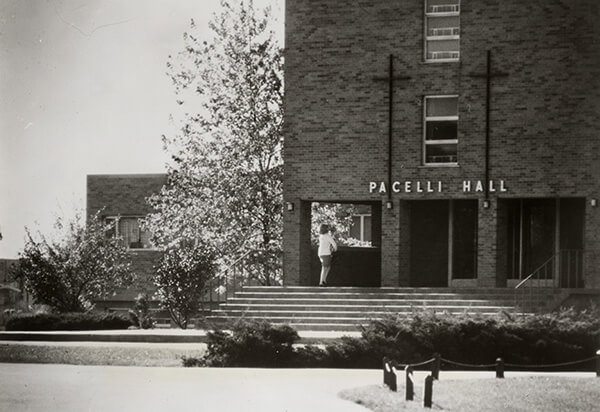
Pacelli Hall, Saint Xavier's first free-standing residence hall, opens.

1956
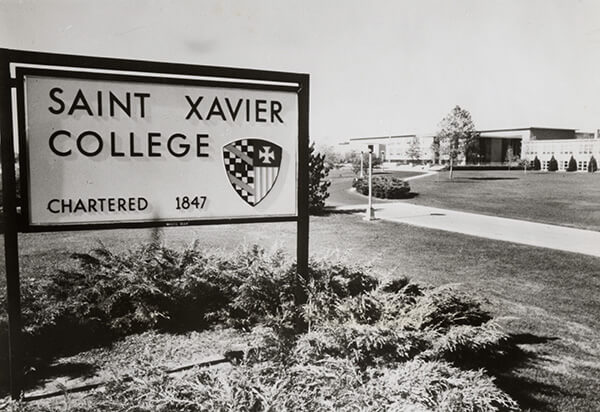
Saint Xavier College moves to a new campus at 103rd Street and Central Park Avenue.
Coincident with the move, the College and the Academy separate and the Academy becomes
McAuley Liberal Arts High School.

1954
Saint Xavier College establishes its Center for Liberal Studies in Education.

1953
Saint Xavier College offers its first graduate program (theology).
With grants from Ford Foundation's Fund for the Advancement of Education, Saint Xavier launches "The Saint Xavier Plan for the Liberal Education of the Christian Person," a grammar school through college curriculum centered in the liberal arts and grounded in philosophy and theology.

1949
Saint Xavier College abandons the quarter system in favor of a semester-based academic calendar.

1948
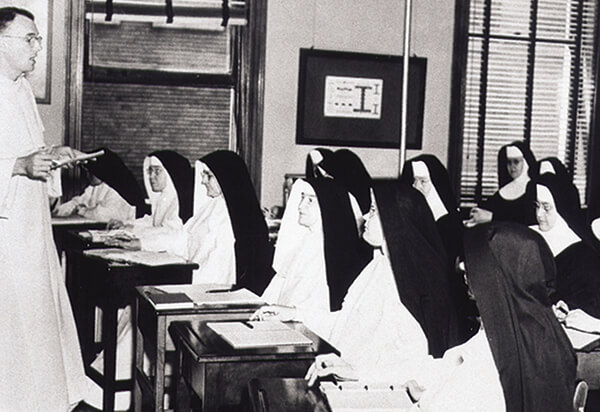
Saint Xavier introduces a summer program in theology for sisters and faces controversy
over the propriety of teaching theology to non-clergy. Undaunted, the summer program
expands to degree status in 1951 and opens to lay persons in 1957.

1937
Saint Xavier College achieves accreditation from the then North Central Association of Secondary Schools and Colleges.

1935
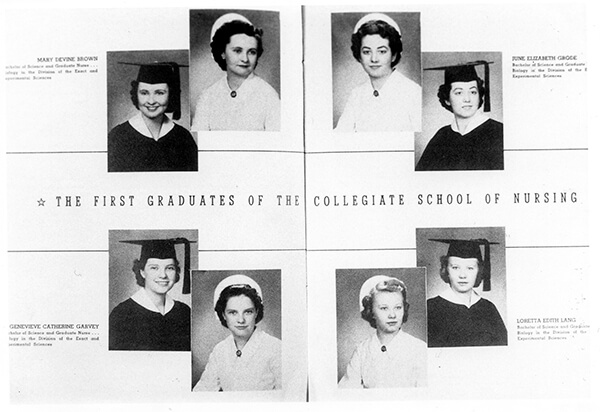
Saint Xavier and Mercy Hospital (Chicago) launch the first integrated baccalaureate
nursing program in Illinois by melding the general education program with hospital-based
laboratory courses and clinical practice hours to create an intensive four-year collegiate
nursing program.

1934
The College announces a rigorous new general education curriculum modeled on its neighbor, the University of Chicago. Sister Camillus Byrne, one of its chief architects, later noted that "opposition arose ... but without vision, there can be no progress."

1919
Saint Xavier College holds its first commencement for a graduating class of two students.

1915
Saint Francis Xavier College for Women opens, welcoming five students and offering a classical program anchored in religion, languages, mathematics and history.

1912
The Sisters of Mercy apply for and receive a certificate of incorporation "to establish, maintain and conduct one or more colleges and ... a university in which may be taught all branches of higher learning." This action marks the sisters' determination to open a Catholic college for women.

1901
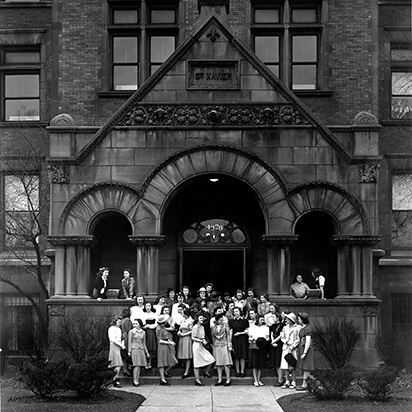
Saint Xavier moves into elegant and expanded new facilities at 49th Street and Cottage
Grove Avenue. Among the features worthy of note -- a telephone!

1873
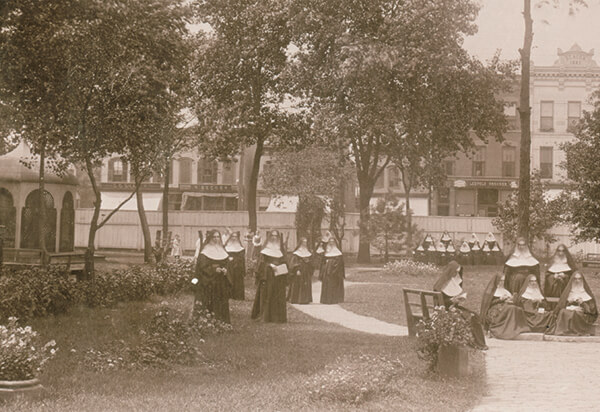
After an interim period in temporary quarters, Saint Xavier Academy takes possession
of an entirely new building at 2834 S. Wabash Avenue in the residential section of
Chicago favored by the Pullmans, Armours, Marshall Field and other dignitaries.

1871
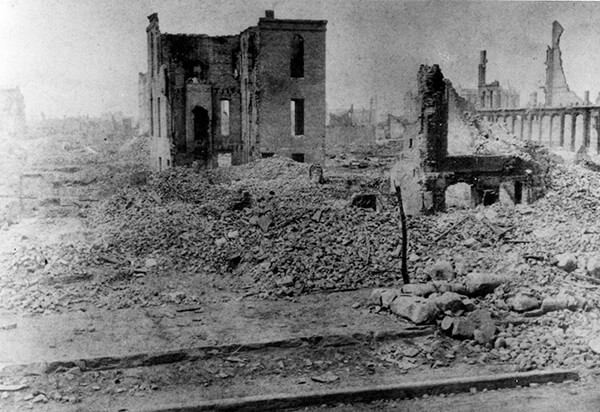
The Great Chicago Fire sweeps through the city, and though no lives were lost among
students or sisters, Saint Xavier is reduced to ruins.

1865
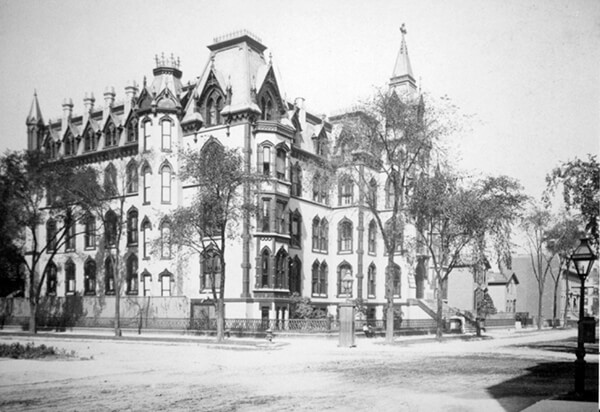
The Academy expands, adding a five-story building at its Wabash Avenue location.

1847
In the fall, the Academy moves to a newly constructed brick facility on Wabash Avenue
near Madison Street in the heart of the city.
The Sisters of Mercy seek and receive an expansive state charter for the Academy, making it a corporation empowered to confer degrees, "appoint a president or principal ... and all such professors or teachers ... as may be necessary ... and prescribe and direct the course of studies to be pursued in said institution." This charter establishes Saint Xavier's claim as the first Mercy institution of higher education in the world, as the first Catholic educational institution still present in Chicago and as one of the oldest continuously operating educational institutions in the metropolitan area.

1846
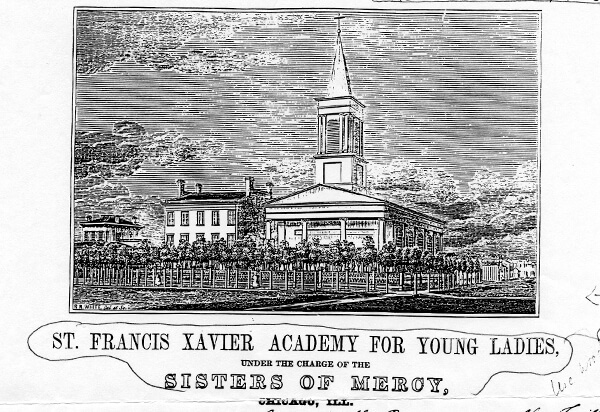 At the request of Bishop Quarter, five Sisters of Mercy arrive from Pittsburgh to
begin the work of Catholic education in Chicago. To honor their leader, Mother Frances
Xavier Warde, they give the name of her patron, St. Francis Xavier, to their original
academy. Saint Francis Xavier Female Academy of Chicago, Illinois opens at Madison
Street and Michigan Avenue in downtown Chicago on October 12, 1846.
At the request of Bishop Quarter, five Sisters of Mercy arrive from Pittsburgh to
begin the work of Catholic education in Chicago. To honor their leader, Mother Frances
Xavier Warde, they give the name of her patron, St. Francis Xavier, to their original
academy. Saint Francis Xavier Female Academy of Chicago, Illinois opens at Madison
Street and Michigan Avenue in downtown Chicago on October 12, 1846.

1844

1837

1831